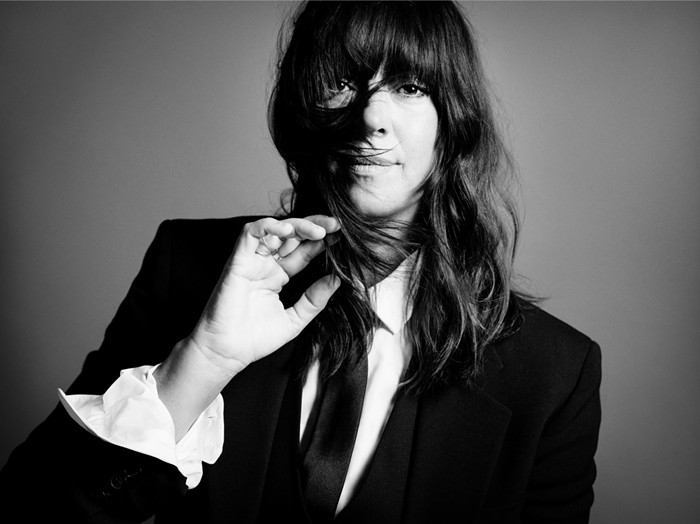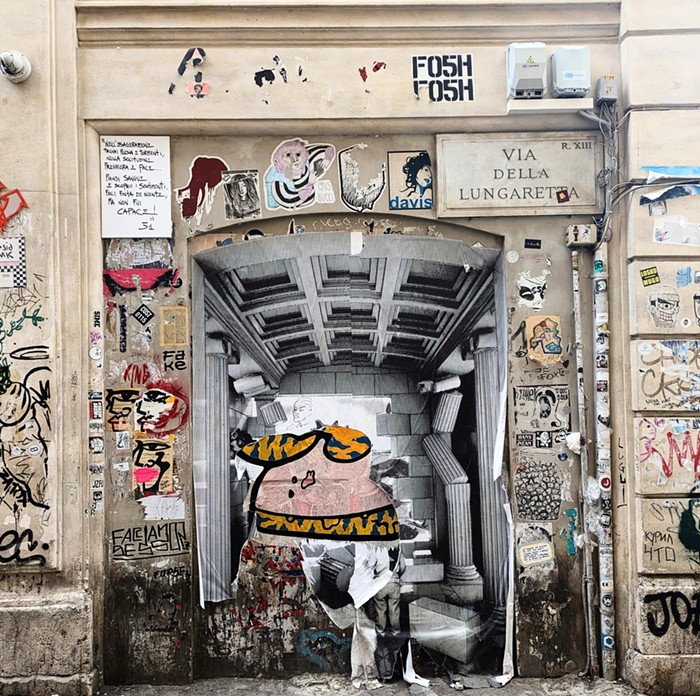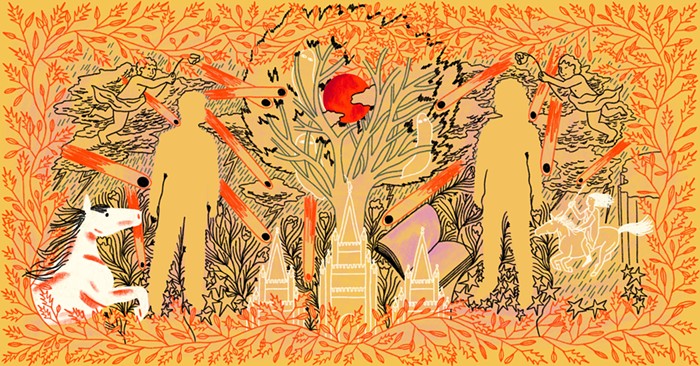The main gallery lined with bolts of blue fur is an excellent touch. The monographs about his early career, the sketches and notes, the videos of fledgling TV puppetry and ad work, even the proto Muppets (the ones that look like gas-pump nozzles are especially good)—it all looks exactly how you'd expect a museum treatment of Jim Henson's career to look.
But none of that prepares you for what happens when you turn the corner and enter the section dedicated to Henson in his prime. One second you're looking at a bunch of drawings and videos, and the next, you're hurtling through a time tunnel that ends at the base of your soul.
I don't know what I could have been expecting, but when I came face-to-face with the actual physical Bert and Ernie in their little striped sweaters, mouths agape in a permanent smile, rubber ducky in hand, I was stunned into silent awe. It only took about five seconds before I burst into tears.
The reality of those two characters, with whom I'd spent so many childhood hours being ushered into comedy, into music, into literacy, into friendship, was frankly overwhelming. The figures themselves were so much larger than I'd ever imagined. Even without legs, they seemed to stand about the size of a child gazing into a television set where his consciousness was being actively molded by the most inspired pair of hands that ever sought to mold a young consciousness.
From that moment on, I staggered through the exhibition in a kind of emotional rapture, each new artifact landing with a visceral power. There's Grover, there's Count von Count, there's Kermit, there's an early Rowlf, Scooter, Dr. Bunsen Honeydew and Beaker, Slimy the worm, and on and on and on. Alongside the puppets themselves are annotated scripts, notes, storyboards, tie-ins, spin-offs, experiments, doodles, diagrams, and behind-the-scenes photos that illustrate the heroic complexity and the revolutionary simplicity of Henson and his collaborators' innovations.
In photos, Henson and his cohort look like an ungainly troupe of smiling, industrious hippies working together in the service of a single vision. They wouldn't have looked out of place at the Oregon Country Fair. It just so happened that they were at the epicenter of what Kermit T. Frog himself would later call "big time showbiz."
This adds a layer of complexity to any serious consideration of Henson's art. Of course it's ingenious. Of course it's hilarious. But it was also as mainstream as mainstream can be, suitable for all ages, and replete with a fundamental, handcrafted goodness of heart that made it positively subversive among popular entertainment. Henson's typed TV pitch letter spelled it out perfectly: "Today's best variety programming on television is fast-paced, uninhibited, free-form entertainment. The Muppet Show is not only within this tradition, it is the epitome of it."
(In case the point wasn't clear, he closed the letter by adding that "the time is right for a variety show hosted by dogs, frogs, and monsters.")
There's no way to achieve that level of success without ambition and calculation, but the exhibition makes it clear that the driving force behind Henson's astonishing career was not merely artistic or artisanal, but benevolent, pedagogical, humanitarian, liberal, good. Take a moment to reflect upon the kinds of ideas that were central to Sesame Street: compassion, cooperation, goodwill, diversity, kindness, gentleness, respect, family in all its forms, love in all its forms. When did you last see any of those values represented on television or film without being cheapened by meretricious manipulation? That's right: When you last watched Sesame Street.
"It's no accident that Henson was involved in Sesame Street," said Barbara Miller, who has been actively working on the Jim Henson exhibition since 2012. As the curator of collections and exhibitions at the Museum of the Moving Image in New York, Miller juggles the demands not only of the show itself, but of the many active stakeholders (corporate and human) in the still very living and lucrative legacy of the late, great genius. A few months after the show opened in Seattle at the Museum of Pop Culture, a similar show, with duplicated or alternate materials (there are several Bert and Ernies), opened at MoMI. That show packs twice as much material into half as much space.
Sesame Street "was an exact response to the arguments that were already going on in the mid-'60s, that TV was a wasteland," Miller said. "That show deliberately set out to counter that perception, and Joan Ganz Cooney and Lloyd Morrisett, the people who put it together initially, were like, 'We won't do this without this guy.'"
Miller pointed out that Henson had been working to realize the best elements of television all along. "Jim sort of orchestrated this process among the builders and the performers and the writers," she said. "It all started at, really, the very early years—like, essentially, in the birth of television. He was on TV in 1955, the very early days."
It's almost as though the birth of the form represented a kind of birth for him as well. "The people that were around when TV was really born were all coming out of other traditions and adapting their genre for the new medium of television," Miller said. "But his puppetry was not adapted for the television from a stage show, unlike all the other people doing puppetry on TV. Henson took those strands of humor from vaudeville and variety, but his medium was the screen, always, always, always the screen. So I think that's a really important distinction, that he's doing it for the love of TV.
"The subtle but critically important thing about Henson is that he begged his parents for a TV. Middle-class America started getting TVs in 1948, and that's when they got their first set. He was enraptured by it and in love with it, and all he wanted to do was be part of it."
It's one of life's great serendipities that Henson's TV ascendancy was concurrent with the rise of divorce rates in America. He became a dominant voice on television just as television was conscripted as the de facto teacher/nanny/confidant for an entire generation of kids. The Muppets taught you how to read, to count, and even to speak, and like all the best teachers, they were funny doing it.
But on a more profound level, the education and entertainment was inscribed with a certain mode of liberal moral instruction, seemingly unsullied by commercial motives, that is utterly absent from contemporary popular entertainment, and increasingly invisible anywhere else, too. Abetted by a cast of theater actors and children of many races and ethnicities, Henson and friends showed the kids on the other side of the glass what it looked like to care about your fellow humans even if you don't belong, to allow yourself to be sad and lonely sometimes, to mourn, to recover, to be accountable to one another.
I know it sounds credulous, and I know things were terrible in the 1970s and '80s, too, but can you honestly say that the global indices for misery, hatred, mistrust, and division haven't gone way up since Jim Henson died? Anyway, that was the impression left by standing amid the monuments of his labor: We may be in the platinum age of television, but who is doing the work of explaining to Big Bird that Mr. Hooper won't be coming back to the corner market?
I hope someone is.
Even if the magnitude of Jim Henson's body of work weren't astonishing, the volume of it would be. Think of the ones that leap to mind right away—Sesame Street, The Muppet Show, the three Muppet movies, the Muppet specials, The Dark Crystal, Labyrinth, and Fraggle Rock (all beautifully represented in the show). Now consider the timeline and think of how many of them overlapped.
Now realize that there were dozens, even hundreds of other projects you never heard of, from TV ads to experimental shorts to short-lived series to film collaborations. The single most striking element in the exhibition is a gigantic wall of TV screens showing every single episode of The Muppet Show simultaneously. That alone could have been a life's work. But to Henson, it was a brief chapter.
If the show makes one thing plain, it's that from the moment he first wrapped a piece of cloth around his hand and made it speak, Henson never, ever stopped working. According to Miller, at the time of his death in 1990, he had something like a thousand unrealized projects.
The thrill of having been alive while Henson was working at the peak of his powers—Sesame Street was four years old when I was born, The Muppet Movie came out when I was 6, Labyrinth arrived two weeks after my 13th birthday, and so on—turns out to have been one of the defining circumstances of my life. No wonder the show reduced me to such a quivering mass. It was exactly like seeing my life pass before my eyes, in vivid, living color, fleece fabric, fur fabric, flocked self-adhesive vinyl, and paint.


















